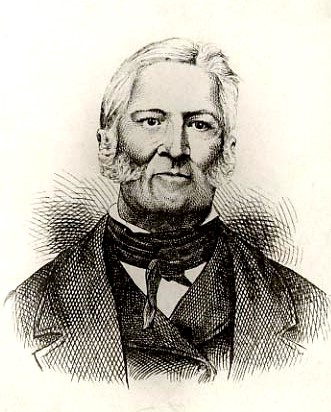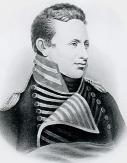|
Jean-Baptiste Faribault
Jean-Baptiste Faribault (October 19, 1775 – August 20, 1860) was a trader with the Native Americans in the United States, Indians and early settler in Minnesota. His father, Barthélemy Faribault, a lawyer of Paris, France, settled in Canada towards the middle of the 18th century and served as military secretary to the France, French army in Canada. After the occupation of the country by the English, he retired to private life in Berthier and he held the office of notary public. Faribault was born in Berthier, Quebec, Berthier, Lower Canada, and received a good school education; after several years of mercantile employment in Quebec, he entered the fur trade, most probably in the employ of Parker, Gerrard, and Ogilvy. In May 1798, he went with others to the island of Michilimackinac or Mackinac, one of the depots of this company. For over ten years, he traded with the Pottowatomic Natives at Kankakee, Illinois, Kankakee, with the Sioux, Dakota or the Sioux, Natives at Re ... [...More Info...] [...Related Items...] OR: [Wikipedia] [Google] [Baidu] |
Jean-Baptiste Faribault By Rosch, C1860
Jean-Baptiste is a male French name, originating with Saint John the Baptist, and sometimes shortened to Baptiste. The name may refer to any of the following: Persons * Charles XIV John of Sweden, born Jean-Baptiste Jules Bernadotte, was King of Sweden and King of Norway * Charles-Jean-Baptiste Bouc, businessman and political figure in Lower Canada * Felix-Jean-Baptiste-Joseph Nève, orientalist and philologist * Gui-Jean-Baptiste Target, French lawyer and politician * Hippolyte Jean-Baptiste Garneray, French painter * Jean-Baptiste (songwriter), American music record producer, singer-songwriter * Jean-Baptiste Alphonse Karr, French critic, journalist, and novelist * Jean-Baptiste Bagaza, chairman of Supreme Revolutionary Council in Burundi until 1976 and president of Burundi (1976-1987) * Jean-Baptiste Baudry, son of Guillaume Baudry, Canadian gunsmith bevear goldsmith * Jean-Baptiste Benoît Eyriès, French geographer, author and translator * Jean-Baptiste Bessières, duk ... [...More Info...] [...Related Items...] OR: [Wikipedia] [Google] [Baidu] |
Faribault County, Minnesota
Faribault County () is a county in the U.S. state of Minnesota. As of the 2020 census, the population was 13,921. Its county seat is Blue Earth. History The county was founded in 1855. It was named for Jean-Baptiste Faribault, a settler and French fur trader among the Sioux Indians. Geography Faribault County lies on the south side of Minnesota. Its southern border abuts the north border of the state of Iowa. The Blue Earth River flows northerly through the west-central part of the county; it enters from Iowa as two branches, West Branch and Middle Branch, merging at 5 miles (8 km) into the county. It is joined by East Branch near the city of Blue Earth, thence flows northward into Blue Earth County. The Maple River flows west-northwestward through the upper central part of the county, entering from Freeborn County and exiting to Blue Earth County. The Cobb River also flows through the NE part of the county, from Freeborn to Blue Earth county. The county terrain consi ... [...More Info...] [...Related Items...] OR: [Wikipedia] [Google] [Baidu] |
Faribault, Minnesota
Faribault ( ) is a city in, and the county seat of, Rice County, Minnesota, United States. The population was 23,352 at the 2010 census. Faribault is approximately south of Minneapolis–Saint Paul. Interstate 35 and Minnesota State Highways 3, 21, and 60 are four of Faribault's main routes. Faribault is situated at the confluence of the Cannon and Straight Rivers in southern Minnesota. History Faribault is regarded as one of the most historic communities in Minnesota, with settlement and commercial activity predating Minnesota's establishment as a U.S. Territory. Until 1745, the area was primarily occupied by the Wahpekute band of Dakotah. Shortly thereafter, the tribe was driven south after several clashes with the Ojibwe over territory. The city's namesake, Alexander Faribault, was the son of Jean-Baptiste Faribault, a French-Canadian fur trader, and Elizabeth Pelagie Kinzie Haines, a Dakotah woman. He is credited with fueling most of the early settlement in the a ... [...More Info...] [...Related Items...] OR: [Wikipedia] [Google] [Baidu] |
Fort Snelling
Fort Snelling is a former military fortification and National Historic Landmark in the U.S. state of Minnesota on the bluffs overlooking the confluence of the Minnesota and Mississippi Rivers. The military site was initially named Fort Saint Anthony, but it was renamed Fort Snelling once its construction was completed in 1825. Before the American Civil War, the U.S. Army supported slavery at the fort by allowing its soldiers to bring their personal enslaved people. These included African Americans Dred Scott and Harriet Robinson Scott, who lived at the fort in the 1830s. In the 1840s, the Scotts sued for their freedom, arguing that having lived in "free territory" made them free, leading to the landmark United States Supreme Court case ''Dred Scott v. Sandford''. Slavery ended at the fort just before Minnesota statehood in 1858. The fort served as the primary center for U.S. government forces during the Dakota War of 1862. It also was the site of the encampment where eastern Dako ... [...More Info...] [...Related Items...] OR: [Wikipedia] [Google] [Baidu] |
Mendota, Minnesota
Mendota is a city in Dakota County, Minnesota, United States. The name is derived from the Dakota language, meaning "mouth or junction of one river with another. The population was 198 at the 2010 census. History The town was one of the first permanent European-American settlements in the state of Minnesota, being founded around the same time as Fort Snelling. It is also the location of the Sibley Historic Site with two of the earliest known stone buildings in the State of Minnesota, the Henry Hastings Sibley house, the Faribault house, and other buildings associated with the American Fur Company, all dating from the 1830s, and the Dupuis House, the first red brick house in Mendota, built in 1854 by Hypolite Dupuis for his wifeAngelique (Renville) Dupuis and his large, growing Dakota mixed-blood family. Hypolite Dupuis arrived in Mendota sometime between 1840, and 1842 and began clerking for Sibley The main route through the small city is State Highway 13, also known as ''Si ... [...More Info...] [...Related Items...] OR: [Wikipedia] [Google] [Baidu] |
Newspapers
A newspaper is a periodical publication containing written information about current events and is often typed in black ink with a white or gray background. Newspapers can cover a wide variety of fields such as politics, business, sports and art, and often include materials such as opinion columns, weather forecasts, reviews of local services, obituaries, birth notices, crosswords, editorial cartoons, comic strips, and advice columns. Most newspapers are businesses, and they pay their expenses with a mixture of subscription revenue, newsstand sales, and advertising revenue. The journalism organizations that publish newspapers are themselves often metonymically called newspapers. Newspapers have traditionally been published in print (usually on cheap, low-grade paper called newsprint). However, today most newspapers are also published on websites as online newspapers, and some have even abandoned their print versions entirely. Newspapers developed in the 17th ... [...More Info...] [...Related Items...] OR: [Wikipedia] [Google] [Baidu] |
Mississippi River
The Mississippi River is the second-longest river and chief river of the second-largest drainage system in North America, second only to the Hudson Bay drainage system. From its traditional source of Lake Itasca in northern Minnesota, it flows generally south for to the Mississippi River Delta in the Gulf of Mexico. With its many tributaries, the Mississippi's watershed drains all or parts of 32 U.S. states and two Canadian provinces between the Rocky and Appalachian mountains. The main stem is entirely within the United States; the total drainage basin is , of which only about one percent is in Canada. The Mississippi ranks as the thirteenth-largest river by discharge in the world. The river either borders or passes through the states of Minnesota, Wisconsin, Iowa, Illinois, Missouri, Kentucky, Tennessee, Arkansas, Mississippi, and Louisiana. Native Americans have lived along the Mississippi River and its tributaries for thousands of years. Most were hunter-ga ... [...More Info...] [...Related Items...] OR: [Wikipedia] [Google] [Baidu] |
Pike Island
Pike Island (Dakota: ''Wita Tanka'') is an island at the confluence of the Mississippi and Minnesota rivers in the southwestern-most part of Saint Paul in the U.S. state of Minnesota. The island is managed as part of Fort Snelling State Park and is within the Mississippi National River and Recreation Area. For centuries, Dakota people have considered the area of the island to be a sacred place where they moved with the seasons to find food and resources. The island is named after Zebulon Pike, who negotiated the United States government purchase of the area from Mdewakanton Sioux Indians in 1805. History For centuries, Dakota people have considered the confluence area of the Mississippi and Minnesota rivers to be a sacred place, Bdote, which means “where two waters come together.” The two bluffs area was considered of place of creation, where the Earth gave rise to the first Dakota man and woman. In September 1805, the island was part of a land purchased from the Mdewak ... [...More Info...] [...Related Items...] OR: [Wikipedia] [Google] [Baidu] |
United States
The United States of America (U.S.A. or USA), commonly known as the United States (U.S. or US) or America, is a country primarily located in North America. It consists of 50 states, a federal district, five major unincorporated territories, nine Minor Outlying Islands, and 326 Indian reservations. The United States is also in free association with three Pacific Island sovereign states: the Federated States of Micronesia, the Marshall Islands, and the Republic of Palau. It is the world's third-largest country by both land and total area. It shares land borders with Canada to its north and with Mexico to its south and has maritime borders with the Bahamas, Cuba, Russia, and other nations. With a population of over 333 million, it is the most populous country in the Americas and the third most populous in the world. The national capital of the United States is Washington, D.C. and its most populous city and principal financial center is New York City. Paleo-Americ ... [...More Info...] [...Related Items...] OR: [Wikipedia] [Google] [Baidu] |
War Of 1812
The War of 1812 (18 June 1812 – 17 February 1815) was fought by the United States of America and its indigenous allies against the United Kingdom and its allies in British North America, with limited participation by Spain in Florida. It began when the United States declared war on 18 June 1812 and, although peace terms were agreed upon in the December 1814 Treaty of Ghent, did not officially end until the peace treaty was ratified by Congress on 17 February 1815. Tensions originated in long-standing differences over territorial expansion in North America and British support for Native American tribes who opposed US colonial settlement in the Northwest Territory. These escalated in 1807 after the Royal Navy began enforcing tighter restrictions on American trade with France and press-ganged men they claimed as British subjects, even those with American citizenship certificates. Opinion in the US was split on how to respond, and although majorities in both the House and ... [...More Info...] [...Related Items...] OR: [Wikipedia] [Google] [Baidu] |

.jpg)



